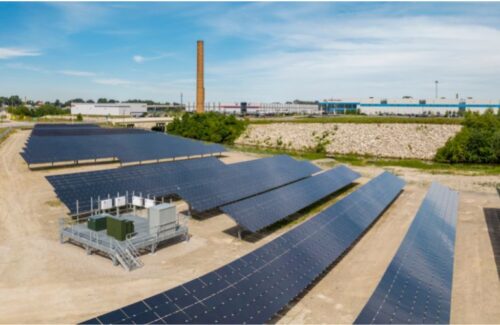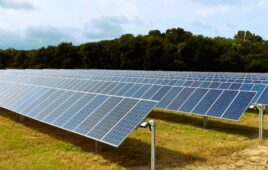
Yaskawa Solectria string inverters on a thin-film solar project.
Potential induced degradation (PID) has haunted the solar industry since its origin. This phenomenon happens when the high-voltage DC side of a solar project is installed next to other equipment with differing voltage. The discrepancy can induce sodium migration, where electrons enclosed in module glass escape and speed up module degradation.
“That inherent big magnitude drives this PID behavior, if the modules or the power electronics are not designed in a particular way to mitigate this,” said Steven Marsh, senior director of technology and design at large-scale developer Origis Energy.
Thin-film modules are more susceptible to PID because of their higher voltage and material makeup, but crystalline silicon panels are also at risk if there are any flaws in the wafers. Developer Silicon Ranch prioritizes anti-PID functionality for string inverters on both types of projects.
“They’re made different, but it’s the same overarching worry that a solar designer has to have, which is these minor weaknesses in the solar panels, you guard against with anti-PID features in your inverters,” said Nick de Vries, SVP of technology and asset management at Silicon Ranch.
When new panel technology comes out, it often takes some time to hone the product to reduce the risk of PID. Early models of glass-on-glass bifacial modules had issues with PID, but manufacturers have made strides since then, Marsh said.
“[PID] comes back from time to time as the technology evolves, just because it’s very new and it’s evolving. It’s a very demanding condition that modules have to go through,” he said.
Central inverters are a safe bet for avoiding PID. They include built-in transformers that are negatively grounded, isolating the DC and AC sides of the system.
But as transformerless string inverters are increasingly deployed on larger projects for their O&M simplicity, with thin-film panels and otherwise, project owners must now consider PID mitigation.
“There are a few key ways that you can achieve galvanic isolation, and a transformer is one of them. Making that change to transformerless unfortunately creates that issue,” Marsh said. “The PV array will end up floating, and usually what that means is about half the modules in the entire system will experience a negative bias relative to ground.”
A few methods can be used to help avoid PID in transformerless string inverters. Installers can add a grounded isolation transformer or ground the step-up transformer on the AC side. And manufacturers are now adding special hardware and software to string inverters to combat PID.
Marsh said there are two categories of PID mitigation in string inverters — active anti-PID methods and passive PID recovery modes. Active anti-PID hardware and software solutions take the DC side of the system and elevate the voltage so all modules are above ground. On the other end, PID recovery methods work at night to undo the PID accumulated during the day. However, thin-film manufacturer First Solar says its modules respond more favorably to active anti-PID functionality rather than PID recovery.
SMA string inverters on a Silicon Ranch thin-film project.
A few string inverter manufacturers on the market now include anti-PID hardware and accompanying software to protect from degradation, or sell separate accessories to perform the protective functions. For example, CPS America offers the CPS Energy Balancer, while Sungrow builds anti-PID hardware into its SG125HV and SG250HX string inverters. Sungrow started offering anti-PID string inverters around 2018.
“There were questions about the degradation rates of panels in general at the time, so we developed the solution,” said Daniel Friberg, director of product and engineering at Sungrow.
Yaskawa Solectria recently announced an anti-PID version of its XGI 1500-250 series string inverter that’s tailored to work with First Solar thin-film modules.
“That takes a few small changes internal to the inverter. It’s not a huge deal, but it does require some engineering time and a listing update for a brand-new specific model in this series, so we are in the midst of proving that out in the lab,” said Miles Russell, director of product management at Yaskawa Solectria Solar.
Both Solectria and First Solar make their products in the United States, giving installers an easy pairing to achieve domestic content incentive goals included in the IRA. But they discussed PID mitigation well before the IRA was written.
“We started that relationship two years ago, with just purely the goal on a technical level to achieve a product which is easily compatible with our product,” said Alex Kamerer, project manager at First Solar. “We go that extra step to ensuring that we have compatibility with our system providers, which benefits our customers.”
Although more inverter manufacturers are starting to incorporate anti-PID functions in string inverters as the technology is increasingly used in larger projects, engineers still sometimes have to dig through data sheets to check on a product’s anti-PID capabilities, according to Origis’s Marsh.
“We find that there are a few options out there, and they’re not necessarily a big driver in the capital initial cost of the inverter,” he said. “However, these don’t tend to be heavily publicized inverter features, maybe because the topic is very, very technical, or even [because] PID itself is pretty hard to detect in the field. So we certainly see some transformerless inverters that come without this function.”
But mitigating PID is going to become even more important as solar companies now have the option to take the production tax credit (PTC) in the IRA. Keeping degradation in check so the modules produce maximum power for as long as possible will be crucial for tax credit certainty.
“I think having a widespread industry understanding of the factors in PID is probably what needs to increase — education about the times that your modules may be prone to PID, as well as detection methods,” Marsh said.




““There are a few key ways that you can achieve galvanic isolation, and a transformer is one of them. Making that change to transformerless unfortunately creates that issue,” Marsh said. “The PV array will end up floating, and usually what that means is about half the modules in the entire system will experience a negative bias relative to ground.””
Interesting, this is perhaps why company Sonnen has a 48VDC powered Radian Inverter to help prevent the need for high panel string voltages in the residential market.